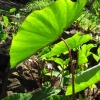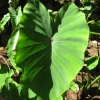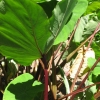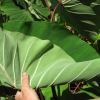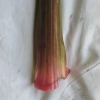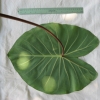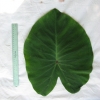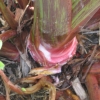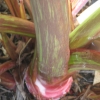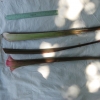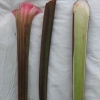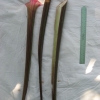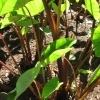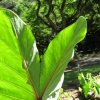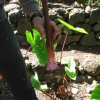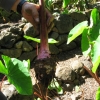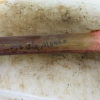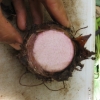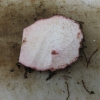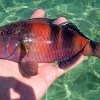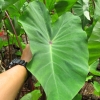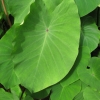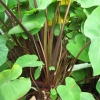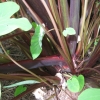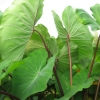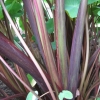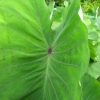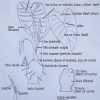Use As Food
Both for poi and as table taro, mainly for home consumption.
Distribution
Planted in a few scattered locations throughout the islands, usually under māla (upland) culture.
General Characteristics
Medium in height, moderately spreading, maturing within 8 to 10 months, producing from 5 to 10 ‘ohā; characterized by reddish-purple Hā (Petiole) with inconspicuous yellowish-green stripes.
Ha (Petiole)
70 to 95 cm. long, red near kōhina (base) shading to reddish-purple above, with inconspicuous yellowish-green stripes especially on the midsection, indistinctly dark reddish at the lihi (the stem edge), a dark red ring at kōhina (base) with dark pink for 3 to 5 cm. above the base.
Lau or Lu'au(Leaf Blade)
35 to 45 cm. long, 25 to 35 cm. wide, 25 to 35 cm. from tip to base of sinus (māwae), egg-shaped (ovate), dark glossy green with bluish cast; piko large, distinct, purple; primary and marginal veins reddish on lower surface; round leaf section (lobes) obtuse with narrow lihi māwae (sinus).
'I'o kalo (Corm)
Flesh white with pinkish tinge, especially near the top (apex), the fibers yellowish; skin pinkish-lilac.
Pua (Flower)
Remarks
48. ‘Ula‘ula Kūmū and 50. ‘Ula‘ula Moano are similar in appearance and both named after the goatfish. The difference is ‘Ula‘ula Kūmū's Hā (petiole) has white stripes, and ‘Ula‘ula Moano's Hā has green stripes. We call these two brothers since they start with "U."

